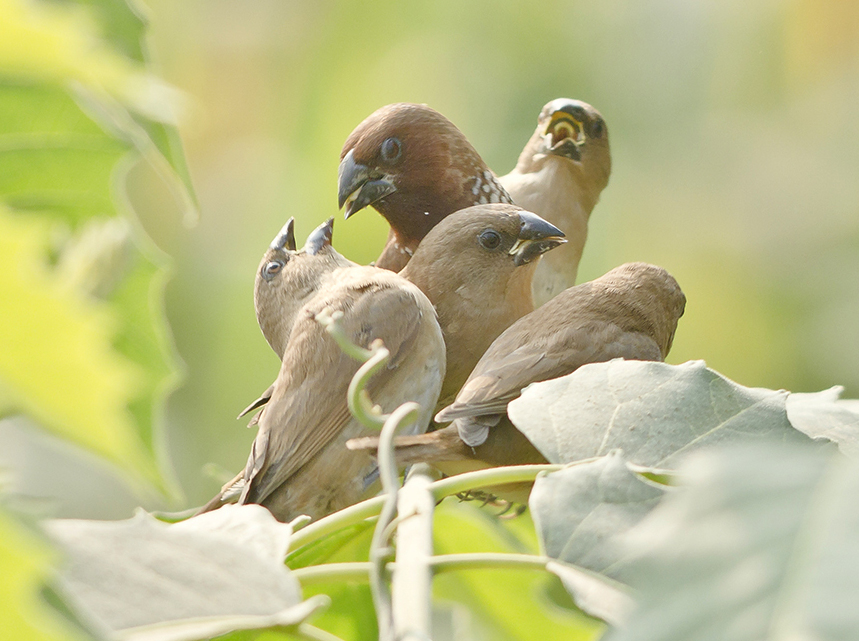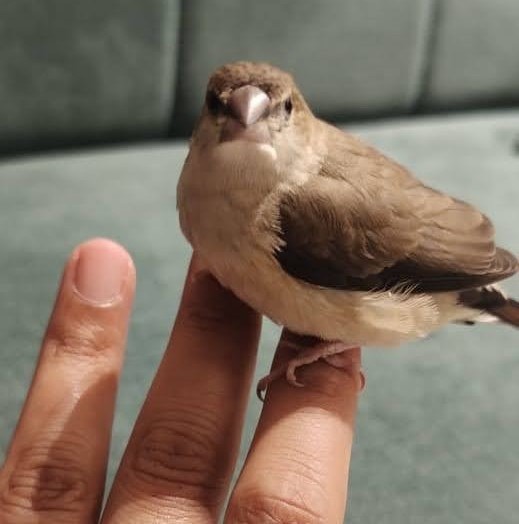|
Lonchura
''Lonchura'' is a genus of the estrildid finch family, and includes munias (or minias) and mannikins. They are seed-eating birds that are found in South Asia from India, Bangladesh, Sri Lanka east to Indonesia, Papua New Guinea, and the Philippines. The name mannikin is from Middle Dutch ''mannekijn'' 'little man', and also the source of the common name of the family Pipridae, manakin. Some of the ''Lonchura'' species were formerly placed in ''Spermestes''. Others have been placed in a genus of their own, '' Euodice''. Characteristics They are small gregarious birds which feed mainly on seeds, usually in relatively open habitats, preferring to feed on the ground or on reeds of grasses. Several species have been noted to feed on algae such as ''Spirogyra''. The nest is a large domed grass structure into which four to ten white eggs are laid. Some species also build communal roosting nests for overnight rest. The species in this genus are similar in size and structure, wit ... [...More Info...] [...Related Items...] OR: [Wikipedia] [Google] [Baidu] |
Scaly-breasted Munia
The scaly-breasted munia or spotted munia (''Lonchura punctulata''), known in the pet trade as nutmeg mannikin or spice finch, is a Old World sparrow, sparrow-sized estrildid finch native to tropical Asia. A species of the genus ''Lonchura'', it was formally species description, described and named by Carl Linnaeus in 1758. Its name is based on the distinct scale-like feather markings on the breast and belly. The adult is brown above and has a dark conical bill. The species has 11 subspecies across its range, which differ slightly in size and colour. This munia eats mainly grass seeds apart from berries and small insects. They Foraging, forage in flocks and communicate with soft Bird vocalization, calls and whistles. The species is highly Behavioral ecology#Social behaviors, social and may sometimes roost with other species of munias. This species is found in tropical plains and grasslands. Breeding pairs construct dome-shaped nests using grass or bamboo leaves. The species is e ... [...More Info...] [...Related Items...] OR: [Wikipedia] [Google] [Baidu] |
Lonchura Punctulata (Nagarhole, 2004)
The scaly-breasted munia or spotted munia (''Lonchura punctulata''), known in the pet trade as nutmeg mannikin or spice finch, is a sparrow-sized estrildid finch native to tropical Asia. A species of the genus ''Lonchura'', it was formally described and named by Carl Linnaeus in 1758. Its name is based on the distinct scale-like feather markings on the breast and belly. The adult is brown above and has a dark conical bill. The species has 11 subspecies across its range, which differ slightly in size and colour. This munia eats mainly grass seeds apart from berries and small insects. They forage in flocks and communicate with soft calls and whistles. The species is highly social and may sometimes roost with other species of munias. This species is found in tropical plains and grasslands. Breeding pairs construct dome-shaped nests using grass or bamboo leaves. The species is endemic to Asia and occurs from India and Sri Lanka east to Indonesia and the Philippines (where it is c ... [...More Info...] [...Related Items...] OR: [Wikipedia] [Google] [Baidu] |
Scaly-breasted Munia
The scaly-breasted munia or spotted munia (''Lonchura punctulata''), known in the pet trade as nutmeg mannikin or spice finch, is a Old World sparrow, sparrow-sized estrildid finch native to tropical Asia. A species of the genus ''Lonchura'', it was formally species description, described and named by Carl Linnaeus in 1758. Its name is based on the distinct scale-like feather markings on the breast and belly. The adult is brown above and has a dark conical bill. The species has 11 subspecies across its range, which differ slightly in size and colour. This munia eats mainly grass seeds apart from berries and small insects. They Foraging, forage in flocks and communicate with soft Bird vocalization, calls and whistles. The species is highly Behavioral ecology#Social behaviors, social and may sometimes roost with other species of munias. This species is found in tropical plains and grasslands. Breeding pairs construct dome-shaped nests using grass or bamboo leaves. The species is e ... [...More Info...] [...Related Items...] OR: [Wikipedia] [Google] [Baidu] |
Estrildid Finch
Estrildidae, or estrildid finches, is a family (taxonomy), family of small seed-eating passerine birds of the Old World tropics and Australasia. They comprise species commonly known as munias, mannikins, firefinches, parrotfinches and waxbills. They are gregarious and often colonial seed predation, seed eaters with short, thick, but pointed bills. They are all similar in structure and habits, but vary widely in plumage colours and patterns. All estrildids build large, domed nests and lay five to ten white eggs. Many species build roost nests. Some of the firefinches and pytilias are hosts to the brood parasitism, brood-parasitic indigobirds and indigobird, whydahs, respectively. Most are sensitive to cold and require warm, usually tropical, habitats, although a few, such as the eastern alpine mannikin, mountain firetail, red-browed finch, and the genus ''Stagonopleura'', have adapted to the cooler climates of southern Australia and the highlands of New Guinea. The smallest ... [...More Info...] [...Related Items...] OR: [Wikipedia] [Google] [Baidu] |
Lonchura Castaneothorax
The chestnut-breasted mannikin (''Lonchura castaneothorax''), also known as the chestnut-breasted munia or bully bird (in Australia), is a small brown-backed munia with a black face and greyish crown and nape. It has a broad ferruginous breast bar above a white belly. The species is found in Australia, New Caledonia, Indonesia, and Papua New Guinea. This species has also been introduced to French Polynesia. Subspecies and location The chestnut-breasted mannikin has a total of six subspecies and seven forms. The subspecies are as follows: * ''L. c. castaneothorax'' – (John Gould, Gould, 1837): Nominate subspecies#Nominotypical subspecies and subspecies autonyms, nominate, occurs in eastern Australia. * ''L. c. assimilis'' – Mathews, 1910: occurs in northern Australia. Not recognized as a valid subspecies by some authorities. Identification: Richer breast and cream ground color to belly and flanks. * ''L. c. ramsayi'' – Jean Théodore Delacour, Delacour, 1943: occurs in southe ... [...More Info...] [...Related Items...] OR: [Wikipedia] [Google] [Baidu] |
Indian Silverbill
The Indian silverbill or white-throated munia (''Euodice malabarica'') is a small passerine bird found in the Indian Subcontinent and adjoining regions that was formerly considered to include the closely related African silverbill (''Euodice cantans''). This estrildid finch is a common resident breeding bird in the drier regions of the Middle East and the Indian Subcontinent. It has also been introduced into many other parts of the world and has become established in some areas. They forage in small flocks in grassland and scrub habitats. Taxonomy The Indian silverbill was Species description, formally described by the Swedish naturalist Carl Linnaeus in 1758 in the 10th edition of Systema Naturae, tenth edition of his ''Systema Naturae''. He placed the species with the crossbills in the genus ''Loxia'' and coined the binomial nomenclature, binomial name ''Loxia malabarica''. The specific epithet is from the Malabar Coast, Malbar region on the west coast of India. Linnaeus specif ... [...More Info...] [...Related Items...] OR: [Wikipedia] [Google] [Baidu] |
Black-throated Munia
The black-throated munia or Jerdon's mannikin (''Lonchura kelaarti'') is a small passerine bird. This estrildid finch is a resident breeding bird in the hills of southwest India, the Western Ghats, Eastern Ghats and Sri Lanka. Habitat The black-throated munia is a small gregarious bird which feeds mainly on seeds. It frequents open hill woodland and cultivation. The nest is a large domed grass structure in a tree or creepers on a house into which 3-8 white eggs are laid in India, and usually five in Sri Lanka. Characteristics The black-throated munia is 12 cm in length with a long black tail. The adult of the southwest Indian population, ''L. k. jerdoni'', has a stubby grey bill, dark brown upperparts with pale shaft streaks; a blackish face and bib; and pinkish brown underparts with scaly marking towards the vent. The Eastern Ghats form ''vernayi'' has paler pinkish underparts. The nominate form ''L. k. kelaarti'' of Sri Lanka has scaly patterning on the underparts ... [...More Info...] [...Related Items...] OR: [Wikipedia] [Google] [Baidu] |
African Silverbill
The African silverbill (''Euodice cantans'') is a small passerine bird formerly considered conspecific with the Asian species Indian silverbill, (''Euodice malabarica''). This estrildid finch is a common resident breeding bird in dry savanna habitat, south of the Sahara Desert. This species has also been introduced to other countries such as Portugal, Qatar and United States. Taxonomy The African silverbill was formally described in 1789 by the German naturalist Johann Friedrich Gmelin under the binomial name ''Loxia cantans''. The specific epithet is from Latin and means "singing". Gmemlin specified the locality as Africa but this was restricted to Dakar in Senegal by William Lutley Sclater and Cyril Mackworth-Praed in 1918. It is now placed with the Indian silverbill in the genus '' Euodice'' that was introduced in 1862 by the German naturalist Ludwig Reichenbach. In early literature, the African silverbill and the Indian silverbill (''E. malabarica'') were treated as ... [...More Info...] [...Related Items...] OR: [Wikipedia] [Google] [Baidu] |
Euodice
''Euodice'' is a genus of small seed-eating birds in the family Estrildidae. These species are from the dry zones of Africa and India and are commonly referred to as silverbills. They were formerly included in the genus ''Lonchura''. The grey-headed silverbill, which shares the name "silverbill", is a member of the same family but is placed in the genus ''Spermestes''. Taxonomy The genus ''Euodice'' was introduced in 1862 by the German naturalist Ludwig Reichenbach. The name combines the Ancient Greek ''eu'' meaning "good" with ''ōdikos'' meaning "musical" or "singing". The type species was designated as the African silverbill in 1890 by Richard Bowdler Sharpe. The Indian and Africa silverbills were formerly placed in the genus ''Lonchura''. A molecular phylogenetic study published in 2020 found that these species formed a clade In biology, a clade (), also known as a Monophyly, monophyletic group or natural group, is a group of organisms that is composed of a common an ... [...More Info...] [...Related Items...] OR: [Wikipedia] [Google] [Baidu] |
Coenraad Jacob Temminck
Coenraad Jacob Temminck (; 31 March 1778 – 30 January 1858) was a Dutch people, Dutch patrician, Zoology, zoologist and museum director. Biography Coenraad Jacob Temminck was born on 31 March 1778 in Amsterdam in the Dutch Republic. From his father, Jacob Temminck, who was treasurer of the Dutch East India Company with links to numerous travellers and collectors, he inherited a large collection of bird specimens. His father was a good friend of Francois Levaillant who also guided Coenraad. Temminck's ''Manuel d'ornithologie, ou Tableau systématique des oiseaux qui se trouvent en Europe'' (1815) was the standard work on European birds for many years. He was also the author of ''Histoire naturelle générale des Pigeons et des Gallinacées'' (1813–1817), illustrated by Pauline Rifer de Courcelles, Pauline Knip. He wrote ''Nouveau Recueil de Planches coloriées d'Oiseaux'' (1820–1839), and contributed to the mammalian sections of Philipp Franz von Siebold's ''Fauna jap ... [...More Info...] [...Related Items...] OR: [Wikipedia] [Google] [Baidu] |
Genus
Genus (; : genera ) is a taxonomic rank above species and below family (taxonomy), family as used in the biological classification of extant taxon, living and fossil organisms as well as Virus classification#ICTV classification, viruses. In binomial nomenclature, the genus name forms the first part of the binomial species name for each species within the genus. :E.g. ''Panthera leo'' (lion) and ''Panthera onca'' (jaguar) are two species within the genus ''Panthera''. ''Panthera'' is a genus within the family Felidae. The composition of a genus is determined by taxonomy (biology), taxonomists. The standards for genus classification are not strictly codified, so different authorities often produce different classifications for genera. There are some general practices used, however, including the idea that a newly defined genus should fulfill these three criteria to be descriptively useful: # monophyly – all descendants of an ancestral taxon are grouped together (i.e. Phylogeneti ... [...More Info...] [...Related Items...] OR: [Wikipedia] [Google] [Baidu] |







